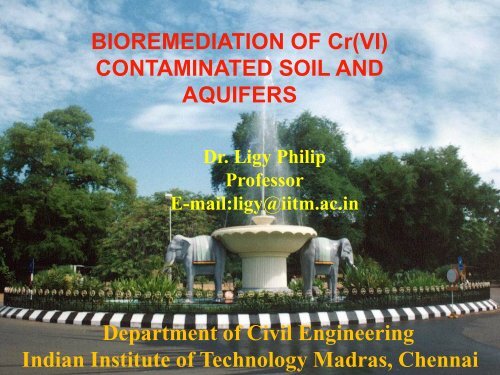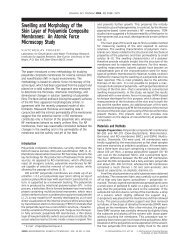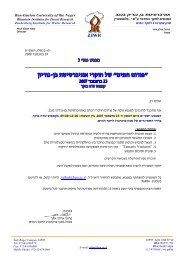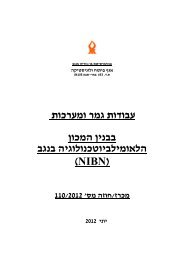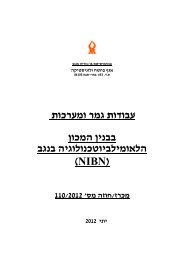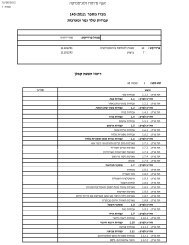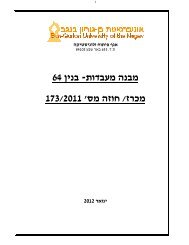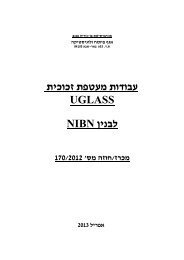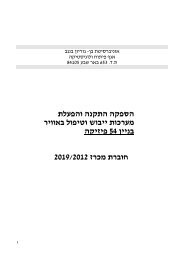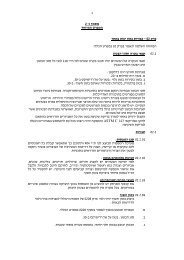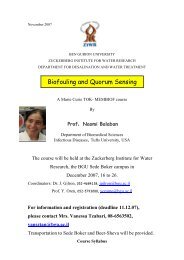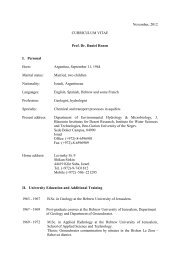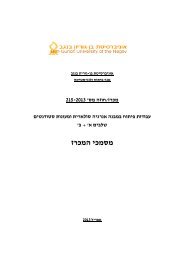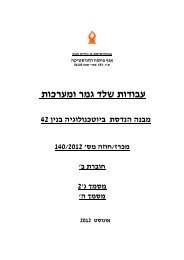BIOREMEDIATION OF Cr(VI) CONTAMINATED SOIL AND AQUIFERS
BIOREMEDIATION OF Cr(VI) CONTAMINATED SOIL AND AQUIFERS
BIOREMEDIATION OF Cr(VI) CONTAMINATED SOIL AND AQUIFERS
Create successful ePaper yourself
Turn your PDF publications into a flip-book with our unique Google optimized e-Paper software.
<strong>BIOREMEDIATION</strong> <strong>OF</strong> <strong>Cr</strong>(<strong>VI</strong>)<br />
<strong>CONTAMINATED</strong> <strong>SOIL</strong> <strong>AND</strong><br />
<strong>AQUIFERS</strong><br />
Dr. Ligy Philip<br />
Professor<br />
E-mail:ligy@iitm.ac.in<br />
Department of Civil Engineering<br />
Indian Institute of Technology Madras, Chennai
<strong>BIOREMEDIATION</strong><br />
Degradation/transformation of<br />
organic/inorganic contaminants by<br />
indigenous or inoculated micro-organisms.<br />
1. Bio-Stimulation<br />
2. Bio-Augmentation<br />
Types of bioremediation<br />
* In-situ bioremediation<br />
* Ex-situ bioremediation
Prof. Ligy Philip<br />
Prof. B.S. Murty<br />
Dr. R. Elangovan<br />
Dr. S. Shashidhar<br />
Research Team<br />
Mr. Shourirajan<br />
Mr. Ramakrishna<br />
Dr. J. Jeyasing<br />
Mr. Somasundaram<br />
Funding<br />
Department of Biotechnology (DBT), Govt. of India<br />
Ministry of Water Resources (MoWR), Govt. of India<br />
Central Pollution Control Board (CPCB), India
CLEANUP METHODS FOR FIELD CONDITIONS<br />
GROUND SURFACE<br />
L<strong>AND</strong>FILL<br />
LEACHATE<br />
WATER TABLE<br />
INSITU<br />
BIO-REMEDIATION<br />
Movement of Groundwater
MOTIVATION<br />
TamilNadu Chromate Chemicals Limited,<br />
Ranipet, Vellore District , Tamilnadu.
Chromium waste<br />
Disposal area: 5 acres (2 hectares)<br />
2 x10 5 Tones of waste)
Chromium Leachate in Ground Water
<strong>Cr</strong>(<strong>VI</strong>) Concentration in open wells/bore<br />
wells in and around TCCL (Prepared by IIT Madras)<br />
TCCL<br />
BDL mg/l<br />
178 mg/l<br />
SIPCOT Service Road<br />
To Banglore<br />
NH - 4<br />
To Ranipet/Chennai<br />
BDL mg/l<br />
9.6mg/l<br />
BDL mg/l<br />
BDL<br />
271 mg/l<br />
BDL mg/l<br />
141 mg/l<br />
34 mg/l<br />
21 mg/l<br />
BDL<br />
BDL mg/l<br />
BDL mg/l<br />
BDL<br />
BDLl<br />
BDL<br />
0.31 mg/l<br />
BDL<br />
BDL<br />
Pulian Kannu Eri<br />
BDL<br />
BDL<br />
Karai<br />
Eri
Many <strong>Cr</strong>(<strong>VI</strong>) contaminated sites are present in<br />
various parts of the world. Reasons for<br />
contamination are either natural or<br />
anthropogenic<br />
Sukhinda Valley in Orissa<br />
Vaniyambadi in Tamilnadu<br />
Jajmau in Kanpur<br />
Hanford area in U.S.A<br />
Most common treatment method – Reduce<br />
<strong>Cr</strong>(<strong>VI</strong>) to <strong>Cr</strong>(III) and precipitate or adsorb<br />
<strong>Cr</strong>(III).
Methods for Remediation of <strong>Cr</strong>(<strong>VI</strong>)<br />
Contaminated Aquifers<br />
• Pump and Treat systems<br />
• Geochemical fixation<br />
• Permeable Reactive Barriers<br />
• Reactive Zones<br />
• Natural attenuation<br />
• Phyto-remediation
Schematic Representation of a Permeable Reactive Bio-barrier
REACTIVE ZONES
TASKS<br />
1<br />
Isolation and Enrichment of Bacteria for<br />
<strong>Cr</strong>(<strong>VI</strong>) Reduction [CRB / IRB / SRB]
Abiotic Reduction<br />
• Reduction of <strong>Cr</strong> (<strong>VI</strong>) by aqueous phase Fe (II)<br />
3Fe 2+ + H<strong>Cr</strong>O 4<br />
-<br />
+ 8H 2 O 3 Fe (OH) 3 + <strong>Cr</strong> (OH) 3<br />
+ 5H +<br />
• Fe (II) sources<br />
Iron silicates-olivine<br />
Iron oxides - magnetite (Fe 2+ Fe 2<br />
3+<br />
0 4 ), hematite (Fe 2<br />
3+<br />
O 3 )<br />
contains (FeO).<br />
Iron sulfides FeS 2<br />
• Organic matters (humic and fulvic acids)<br />
<strong>Cr</strong> 2 O<br />
2-<br />
7 + 3C 0 + 16H + 4<strong>Cr</strong> 3+ + 3CO 2 +<br />
8H 2 O
Biotic Reduction<br />
Advantages<br />
Less cost and chemical usage<br />
Requires minimal maintenance<br />
• Direct reduction (CRB)<br />
Aerobic/Anaerobic<br />
– Pseudomonas fluorescens<br />
– P. aeruginosa<br />
– Enterobacter cloacae<br />
– Bacillus sp<br />
– A. radiobacter etc.<br />
• Indirect reduction<br />
‣Iron reducing<br />
bacteria –mostly<br />
anaerobic condition.<br />
‣Sulphate reducing<br />
bacteria- strictly<br />
anaerobes
Mechanism of <strong>Cr</strong> (<strong>VI</strong>) Reduction by CRB<br />
• Aerobic<br />
– NADH /Endogenous e - reserves acts as<br />
donors<br />
– Enzyme Soluble Reductase (SR)<br />
Membrane Reductase (MR)<br />
• Anaerobic<br />
– <strong>Cr</strong> (<strong>VI</strong>) acts as terminal electron<br />
acceptor<br />
– NADH ,Endogenous e - reserves,<br />
carbohydrates, proteins, Hydrogen acts<br />
as donors<br />
– SR, MR, Cytochromes mediates reaction<br />
C 6 H 12 O 6 + 8<strong>Cr</strong> 6+ + 12H 2<br />
O 6HCO 3-<br />
+ 8<strong>Cr</strong> 3+ + 3OH - (aerobic and anaerobic)<br />
COD of 1g Glucose is 1.07g<br />
180 g glucose is required to reduce 416(8x52)g of <strong>Cr</strong> 6+<br />
1g of glucose can reduce 2.311g of <strong>Cr</strong> 6+<br />
1 g of COD can reduce 2.1598g of <strong>Cr</strong> 6+
Mechanism of <strong>Cr</strong>(<strong>VI</strong>) Reduction by SRB<br />
Sulphates acts as terminal electron acceptor<br />
• Reduction of Sulphates<br />
SRB<br />
1/2SO 4<br />
2-<br />
+CH 2<br />
O +1/2 H + 1/2 HS - + H 2<br />
O + CO 2<br />
• Reduction of chromate by Sulphides<br />
8<strong>Cr</strong>O 4<br />
2-<br />
+ 3HS - + 17 H 2<br />
0 8 <strong>Cr</strong> (OH)<br />
3 + 3SO 4 2- +11OH -<br />
• Precipitation of <strong>Cr</strong> (<strong>VI</strong>) by Sulphide<br />
<strong>Cr</strong> 6+ + 3 HS - <strong>Cr</strong>S 3 + 3H +<br />
• Reduction of iron by sulphides:<br />
8 Fe (OH)<br />
3 (aq) + HS- +15H + 8Fe 2+ (aq) + SO 4<br />
2-<br />
+ 20H 2<br />
O<br />
Sulphide inhibition of SRB were reported to 230 to 550 mg/L of un dissociated<br />
H 2 S at pH 6.2 to 8. (Vincent et al., 1998).<br />
<strong>Cr</strong> (<strong>VI</strong>) reduction and iron reduction helps in prevention of Sulphide inhibition
Mechanism of <strong>Cr</strong>(<strong>VI</strong>) Reduction by IRB<br />
Abiotic reduction<br />
The increase in pH cause corrosion which facilitates abiotic chromium reduction<br />
2<strong>Cr</strong> 6+ +6 e − →2<strong>Cr</strong> 3+<br />
3Fe 0 →3Fe 2+ +6 e −<br />
2<strong>Cr</strong> 3+ +6OH − →2<strong>Cr</strong>(OH) 3<br />
2<strong>Cr</strong> 6+ +3Fe 0 +6OH − →2<strong>Cr</strong>(OH) 3<br />
+3Fe 2+<br />
Biotic reduction<br />
IRB<br />
C 6<br />
H 12<br />
O 6<br />
+ 24Fe (III) + 12H 2<br />
O 6HCO 3-<br />
+ 24 Fe (II) + 3OH -<br />
3Fe 2+ + H<strong>Cr</strong>O 4<br />
-<br />
+ 8H 2<br />
O 3 Fe (OH)<br />
3 + <strong>Cr</strong> (OH) 3 + 5H+
2<br />
BATCH STUDIES<br />
• Bio-kinetic parameters<br />
• Adsorption Parameters
<strong>Cr</strong>(<strong>VI</strong>) Reduction Studies with CRB, SRB<br />
and IRB, in Combinations<br />
1. CRB –Aerobic<br />
2. CRB -Anaerobic<br />
2. SRB-Anaerobic<br />
3. IRB- anaerobic<br />
4. CRB+SRB<br />
5. CRB+IRB<br />
6. CRB+SRB+IRB<br />
Adsorption Studies<br />
Adsorbents– Soil , Sand<br />
Adsorbates:<br />
1. <strong>Cr</strong>(<strong>VI</strong>)<br />
2. Molasses/Sugar<br />
3. Lithium<br />
4. <strong>Cr</strong>(III)
<strong>Cr</strong>(<strong>VI</strong>) Reduction in Aerobic Conditions<br />
<strong>Cr</strong> 6+ conc<br />
250<br />
200<br />
150<br />
100<br />
50<br />
0<br />
-50<br />
Chromium(<strong>VI</strong>) reduction<br />
0 50 100 150<br />
time in hrs<br />
0 ppm<br />
20ppm<br />
30ppm<br />
65 ppm<br />
110 ppm<br />
145 ppm<br />
190 ppm<br />
cell dry wt in mg/L<br />
1400<br />
1200<br />
1000<br />
800<br />
600<br />
400<br />
200<br />
0<br />
Growth curve<br />
0 50 100 150<br />
time in hrs<br />
0 ppm<br />
20 ppm<br />
32ppm<br />
66 ppm<br />
110 ppm<br />
140 ppm<br />
190 ppm<br />
COD removal rate<br />
4000<br />
COD in mg/L<br />
3500<br />
3000<br />
2500<br />
2000<br />
1500<br />
1000<br />
500<br />
0 ppm<br />
20 ppm<br />
30 ppm<br />
65ppm<br />
110 ppm<br />
145 ppm<br />
190 ppm<br />
0<br />
0 50 100 150<br />
time in hr
<strong>Cr</strong> (<strong>VI</strong>) Reduction by CRB under Anaerobic Condition<br />
cell dry wt in mg/L<br />
350<br />
300<br />
250<br />
200<br />
150<br />
100<br />
Growth curve<br />
0 ppm<br />
10 ppm<br />
20 ppm<br />
30 ppm<br />
50 ppm<br />
COD in mg/L<br />
3000<br />
2700<br />
2400<br />
2100<br />
1800<br />
COD reduction curve<br />
0 ppm<br />
10 ppm<br />
20ppm<br />
30ppm<br />
50ppm<br />
50<br />
0<br />
0 50 100 150<br />
time in hrs<br />
1500<br />
0 30 60 90 120<br />
time in hr<br />
<strong>Cr</strong> reduction curve<br />
60<br />
50<br />
40<br />
30<br />
20<br />
10<br />
0<br />
-10<br />
0 50 100 150<br />
0 ppm<br />
10 ppm<br />
20 ppm<br />
30 ppm<br />
50 ppm
Growth of CRB+IRB+SRB under Anaerobic Condition<br />
Fe(400ppm,Sulphate(500ppm)<br />
cell dry wt in mg/L<br />
500<br />
400<br />
300<br />
200<br />
100<br />
0<br />
CRB+IRB+SRB growth curve<br />
<strong>Cr</strong>(0) Fe(400) SO4 2- (500)<br />
<strong>Cr</strong>(10) Fe(400) SO4 2- (500)<br />
<strong>Cr</strong>(20) Fe(400) SO4 2- (500)<br />
<strong>Cr</strong>(50) Fe(400) SO4 2- (500)<br />
0 20 40 60 80 100 120 140<br />
Cell dry wt in mg/L<br />
3200<br />
2700<br />
2200<br />
1700<br />
1200<br />
COD removal curve<br />
0 50 100 150<br />
time in hrs<br />
<strong>Cr</strong>(0) Fe(400) SO4 2-<br />
(500)<br />
<strong>Cr</strong>(10) Fe(400) SO4 2-<br />
(500)<br />
<strong>Cr</strong>(20) Fe(400) SO4 2-<br />
(500)<br />
<strong>Cr</strong>(50) Fe(400) SO4 2-<br />
(500)<br />
time in hrs<br />
Sulphate reduction<br />
<strong>Cr</strong>(<strong>VI</strong> ) reduction<br />
<strong>Cr</strong>(0) Fe(400) SO4 2-<br />
(500)<br />
Sulphate conc in mg/L<br />
550<br />
500<br />
450<br />
400<br />
350<br />
300<br />
250<br />
200<br />
0 50 100 150<br />
time in hrs<br />
<strong>Cr</strong>(0) Fe(400) SO4 2-<br />
(500)<br />
<strong>Cr</strong>(10) Fe(400) SO4 2-<br />
(500)<br />
<strong>Cr</strong>(20) Fe(400) SO4 2-<br />
(500)<br />
<strong>Cr</strong>(50) Fe(400) SO4 2-<br />
(500)<br />
<strong>Cr</strong>(<strong>VI</strong>) conc in mg/L<br />
60<br />
50<br />
40<br />
30<br />
20<br />
10<br />
0<br />
0 50 100 150<br />
time in hrs<br />
<strong>Cr</strong>(10) Fe(400) SO4 2-<br />
(500)<br />
<strong>Cr</strong>(20) Fe(400) SO4 2-<br />
(500)<br />
<strong>Cr</strong>(50) Fe(400) SO4 2-<br />
(500)<br />
Fe(II) generation<br />
Fe(II) conc in mg/L<br />
200<br />
150<br />
100<br />
50<br />
0<br />
0 50 100 150<br />
time in hrs<br />
<strong>Cr</strong>(0) Fe(400) SO4 2- (500)<br />
<strong>Cr</strong>(10) Fe(400) SO4 2-<br />
(500)<br />
<strong>Cr</strong>(20) Fe(400) SO4 2-<br />
(500)<br />
<strong>Cr</strong>(50) Fe(400) SO4 2-<br />
(500)
Model<br />
Suffix 1,2,3 represents CRB,SRB,IRB respectively<br />
3<br />
M = ∑ M<br />
i=<br />
1<br />
i<br />
3<br />
S = ∑ S<br />
i=<br />
1<br />
i<br />
3<br />
6<br />
= ∑<br />
i=<br />
1<br />
<strong>Cr</strong> <strong>Cr</strong>6<br />
i<br />
S<br />
i<br />
=<br />
S<br />
⎛<br />
⎜<br />
⎝<br />
M<br />
M<br />
i<br />
⎞<br />
⎟<br />
⎠<br />
<strong>Cr</strong><br />
=<br />
<strong>Cr</strong><br />
6,i 6<br />
⎛<br />
⎜<br />
⎝<br />
M<br />
M<br />
i<br />
⎞<br />
⎟<br />
⎠
⎟<br />
⎟<br />
⎟<br />
⎟<br />
⎠<br />
⎞<br />
⎜<br />
⎜<br />
⎜<br />
⎜<br />
⎝<br />
⎛<br />
⎟<br />
⎠<br />
⎞<br />
⎜<br />
⎝<br />
⎛<br />
+<br />
⎟<br />
⎠<br />
⎞<br />
⎜<br />
⎝<br />
⎛<br />
+<br />
⎟<br />
⎠<br />
⎞<br />
⎜<br />
⎝<br />
⎛<br />
=<br />
M<br />
M<br />
<strong>Cr</strong><br />
K<br />
K<br />
M<br />
M<br />
S<br />
K<br />
M<br />
M<br />
S<br />
M<br />
dt<br />
dM<br />
i<br />
CRB<br />
i<br />
CRB<br />
i<br />
i<br />
CRB<br />
s<br />
i<br />
CRB<br />
CRB<br />
CRB<br />
6<br />
,<br />
,<br />
,<br />
,<br />
.µ max .<br />
⎟<br />
⎟<br />
⎟<br />
⎟<br />
⎠<br />
⎞<br />
⎜<br />
⎜<br />
⎜<br />
⎜<br />
⎝<br />
⎛<br />
⎟<br />
⎠<br />
⎞<br />
⎜<br />
⎝<br />
⎛<br />
+<br />
⎟<br />
⎠<br />
⎞<br />
⎜<br />
⎝<br />
⎛<br />
+<br />
⎟<br />
⎠<br />
⎞<br />
⎜<br />
⎝<br />
⎛<br />
=<br />
M<br />
M<br />
<strong>Cr</strong><br />
K<br />
K<br />
M<br />
M<br />
S<br />
K<br />
M<br />
M<br />
S<br />
M<br />
dt<br />
dM<br />
i<br />
IRB<br />
i<br />
IRB<br />
i<br />
i<br />
IRB<br />
s<br />
i<br />
IRB<br />
IRB<br />
IRB<br />
6<br />
,<br />
,<br />
,<br />
,<br />
.µ max .<br />
⎟<br />
⎟<br />
⎟<br />
⎟<br />
⎠<br />
⎞<br />
⎜<br />
⎜<br />
⎜<br />
⎜<br />
⎝<br />
⎛<br />
⎟<br />
⎠<br />
⎞<br />
⎜<br />
⎝<br />
⎛<br />
+<br />
⎟<br />
⎠<br />
⎞<br />
⎜<br />
⎝<br />
⎛<br />
+<br />
⎟<br />
⎠<br />
⎞<br />
⎜<br />
⎝<br />
⎛<br />
=<br />
M<br />
M<br />
<strong>Cr</strong><br />
K<br />
K<br />
M<br />
M<br />
S<br />
K<br />
M<br />
M<br />
S<br />
M<br />
dt<br />
dM<br />
i<br />
SRB<br />
i<br />
SRB<br />
i<br />
i<br />
SRB<br />
s<br />
i<br />
SRB<br />
SRB<br />
SRB<br />
6<br />
,<br />
,<br />
,<br />
,<br />
.µ max .
<strong>Cr</strong>(<strong>VI</strong>), mg/L<br />
60<br />
50<br />
40<br />
30<br />
20<br />
10<br />
0<br />
10ppm Predicted<br />
10 ppm Experimental<br />
20ppm Predicted<br />
20 ppm Experimental<br />
50 ppm Predicted<br />
50 ppm Experimental<br />
0 10 20 30 40 50 60 70<br />
Time, h<br />
<strong>Cr</strong>(<strong>VI</strong>) reduction by CRB, SRB and IRB under anaerobic<br />
conditions for different initial <strong>Cr</strong>(<strong>VI</strong>) concentrations<br />
Somasundaram et al., Jl. of Hazard. Mater., 2009
3<br />
BENCH SCALE STUDIES
Constant head reservoir<br />
N 2 GAS<br />
Over flow<br />
Soil column<br />
Sample ports<br />
Outlet<br />
Supply tank
Inlet Reservoir<br />
Perforate plate<br />
Sample ports<br />
10 cm<br />
Bio-barrier (soil C)<br />
Outlet Reservoir<br />
Soil B<br />
49 cm<br />
20 cm<br />
Sample<br />
ports<br />
100 cm<br />
10 cm<br />
10<br />
cm<br />
Schematic of experimental setup
30<br />
8<br />
<strong>Cr</strong>(<strong>VI</strong>) mg/L<br />
25<br />
20<br />
15<br />
10<br />
Port at 20 cm<br />
Port at 40 cm<br />
Port at 60 cm<br />
Port at 80 cm<br />
Porevelocity<br />
7<br />
6<br />
5<br />
4<br />
3<br />
Porevelocity cm/h<br />
5<br />
2<br />
0<br />
0 20 40 60 80 100 120 140<br />
Time h<br />
1<br />
<strong>Cr</strong>(<strong>VI</strong>) break-through curve with biotransformation, Soil A<br />
Shashidhar et al., Jl. of Hazard. Mater., 2006
25<br />
25<br />
<strong>Cr</strong>(<strong>VI</strong>) concentration, mg/L<br />
20<br />
15<br />
10<br />
5<br />
<strong>Cr</strong>(<strong>VI</strong>) concentration, mg/L<br />
20<br />
15<br />
10<br />
5<br />
0<br />
0 50 100 150 200 250 300<br />
Time, h<br />
0<br />
0 50 100 150 200 250 300<br />
Time, h<br />
<strong>Cr</strong>(<strong>VI</strong>) breakthrough just before and after Biobarrier BB1<br />
(Bact conc= 0.0205 mg/g of soil)<br />
25<br />
25<br />
<strong>Cr</strong>(<strong>VI</strong>) concentration, mg/L<br />
20<br />
15<br />
10<br />
5<br />
<strong>Cr</strong>(<strong>VI</strong>) concentration, mg/L<br />
20<br />
15<br />
10<br />
5<br />
0<br />
0 10 20 30 40 50 60 70 80 90 100<br />
Time, h<br />
0<br />
0 10 20 30 40 50 60 70 80 90 100<br />
Time, h<br />
<strong>Cr</strong>(<strong>VI</strong>) breakthrough just before and after Biobarrier (BB2)<br />
(Bact conc= 0.205 mg/g of soil)
Transport of <strong>Cr</strong>(<strong>VI</strong>) with Biotransformation<br />
Y<br />
M<br />
dt<br />
dS<br />
dt<br />
dS<br />
R<br />
R<br />
x<br />
S<br />
D<br />
x<br />
S<br />
u<br />
t<br />
S<br />
R<br />
R<br />
x<br />
<strong>Cr</strong><br />
D<br />
x<br />
<strong>Cr</strong><br />
u<br />
t<br />
<strong>Cr</strong><br />
R<br />
kS<br />
kS<br />
s<br />
k<strong>Cr</strong><br />
cr<br />
λµ<br />
=<br />
=<br />
−<br />
∂<br />
∂<br />
=<br />
∂<br />
∂<br />
+<br />
∂<br />
∂<br />
−<br />
∂<br />
∂<br />
=<br />
∂<br />
∂<br />
+<br />
∂<br />
∂<br />
sin<br />
sin<br />
2<br />
2<br />
6<br />
sin<br />
2<br />
2<br />
6<br />
6<br />
6<br />
6
max<br />
max<br />
6<br />
2<br />
2<br />
1<br />
max<br />
]<br />
[<br />
1<br />
0.63<br />
0<br />
0<br />
6<br />
M<br />
if M<br />
M<br />
M<br />
Y<br />
M<br />
R<br />
k<br />
dt<br />
dM<br />
M<br />
S<br />
S<br />
Su<br />
Su<br />
if<br />
<strong>Cr</strong><br />
K<br />
K<br />
Su<br />
K<br />
Su<br />
simk<strong>Cr</strong><br />
d<br />
T<br />
><br />
=<br />
=<br />
−<br />
=<br />
⎟<br />
⎠<br />
⎞<br />
⎜<br />
⎝<br />
⎛<br />
−<br />
=<br />
<<br />
=<br />
⎟<br />
⎟<br />
⎠<br />
⎞<br />
⎜<br />
⎜<br />
⎝<br />
⎛<br />
+<br />
⎟<br />
⎟<br />
⎠<br />
⎞<br />
⎜<br />
⎜<br />
⎝<br />
⎛<br />
+<br />
=<br />
µ<br />
η<br />
λ<br />
µ<br />
λ<br />
µ<br />
µ
30<br />
25<br />
20 cm port Numerical<br />
20 cm port Experimental<br />
30<br />
25<br />
40 cm port Numerical<br />
40 cm port Experimental<br />
<strong>Cr</strong>(<strong>VI</strong>) mg/L<br />
20<br />
15<br />
10<br />
<strong>Cr</strong>(<strong>VI</strong>) mg/L<br />
20<br />
15<br />
10<br />
5<br />
5<br />
0<br />
0 20 40 60 80 100 120 140<br />
Time h<br />
0<br />
0 20 40 60 80 100 120 140<br />
Time h<br />
20 cm Port 40 cm Port<br />
Initial pore velocity 7.3 cm/h<br />
30<br />
25<br />
60 cm port Numerical<br />
60 cm port Experimental<br />
25<br />
20<br />
80 cm port Numerical<br />
80 cm port Experimental<br />
20<br />
<strong>Cr</strong>(<strong>VI</strong>) mg/L<br />
15<br />
10<br />
<strong>Cr</strong>(<strong>VI</strong>) mg/L<br />
15<br />
10<br />
5<br />
5<br />
0<br />
0 20 40 60 80 100 120 140<br />
Time h<br />
60 cm Port 80 cm Port<br />
0<br />
0 20 40 60 80 100 120 140<br />
Time h<br />
Shashidhar et al., Jl. of Hazard. Mater., 2007
4<br />
PILOT SCALE STUDIES
Schematic Diagram of the Reactor<br />
Inlet<br />
Chambe<br />
r<br />
Bio barrier-0.1M<br />
Outlet<br />
chamber<br />
0.2<br />
5
Location of Wells
<strong>Cr</strong> (<strong>VI</strong>) Concentration before the Bio-barrier in<br />
Bioreactor<br />
50<br />
<strong>Cr</strong>(<strong>VI</strong>), mg/L<br />
40<br />
30<br />
20<br />
10<br />
0<br />
-10<br />
0 20 40 60 80 100<br />
Time, days<br />
Well N1<br />
Well N2<br />
Well 2<br />
Well 3<br />
Well 8
<strong>Cr</strong> (<strong>VI</strong>) Concentration after the Bio-barrier in<br />
Bioreactor<br />
Well 11-20<br />
<strong>Cr</strong>(<strong>VI</strong>) mg/L<br />
1<br />
0.8<br />
0.6<br />
0.4<br />
0.2<br />
0<br />
0 50 100<br />
Time, Days<br />
Well 11-20
<strong>Cr</strong> (<strong>VI</strong>) Concentration in the Blank Reactor<br />
before Barrier<br />
<strong>Cr</strong>(<strong>VI</strong>), mg/L<br />
50<br />
40<br />
30<br />
20<br />
10<br />
0<br />
-10<br />
0 50 100<br />
Time, Days<br />
Well B1<br />
Well B2<br />
Well B3<br />
Well B8<br />
well B9
<strong>Cr</strong> (<strong>VI</strong>) Concentration in the Blank Reactor after<br />
the Barrier<br />
50<br />
<strong>Cr</strong>(<strong>VI</strong>) mg/L<br />
40<br />
30<br />
20<br />
10<br />
0<br />
-10<br />
0 50 100<br />
Time, Days<br />
Well B11<br />
Well B12
PLAN <strong>VI</strong>EW <strong>OF</strong> REACTOR CONTANING FOUR<br />
INJECTION WELLS<br />
Injection wells<br />
8<br />
17<br />
22<br />
27<br />
3<br />
12<br />
1<br />
7<br />
11<br />
16<br />
21<br />
26<br />
6<br />
15<br />
20<br />
25<br />
10<br />
5<br />
14<br />
19<br />
24<br />
9<br />
2<br />
4<br />
13<br />
18<br />
23<br />
15 cm<br />
15 cm<br />
35 cm 20 cm<br />
25 cm<br />
Inlet<br />
Chamber<br />
50 cm<br />
25 cm<br />
100 cm
<strong>Cr</strong> (<strong>VI</strong>) Concentration in Reactor before<br />
four Injection wells<br />
300<br />
250<br />
4 wells- well1<br />
<strong>Cr</strong>(<strong>VI</strong>) concentration<br />
Bacteria injected again<br />
was increased form 60<br />
to 250 mg/L<br />
<strong>Cr</strong>(<strong>VI</strong>) , mg/L<br />
200<br />
150<br />
100<br />
50<br />
expt well1<br />
0<br />
0 50 100 150 200 250 300<br />
Time,d
<strong>Cr</strong> (<strong>VI</strong>) Concentration in Reactor after<br />
four Injection wells<br />
60<br />
4 wells - wells 13,15,17<br />
Bacteria injected again<br />
<strong>Cr</strong>(<strong>VI</strong>) , mg/L<br />
50<br />
40<br />
30<br />
20<br />
<strong>Cr</strong>(<strong>VI</strong>) concentration<br />
was increased form<br />
60 to 250 mg/L<br />
Expt well 13<br />
expt well 15<br />
expt well 17<br />
10<br />
0<br />
0 50 100 150 200 250 300<br />
Time,d
MATHEMATICAL MODEL<br />
R<br />
cr<br />
∂<strong>Cr</strong><br />
∂t<br />
+<br />
R<br />
hcr<br />
∂h<br />
∂t<br />
+<br />
( ) = Dˆ<br />
( <strong>Cr</strong>)<br />
Aˆ<br />
<strong>Cr</strong><br />
⎛<br />
− λ.<br />
h.<br />
M.<br />
⎜<br />
⎝<br />
S<br />
⎞ ⎛<br />
⎟.<br />
⎜<br />
⎝<br />
( ) ⎟ ⎜ (<br />
m<br />
K + + ) ⎠<br />
⎟⎟ s<br />
S 1 K<br />
H<br />
. <strong>Cr</strong> ⎠<br />
1<br />
⎞<br />
R<br />
S<br />
∂S<br />
∂t<br />
+<br />
R<br />
hS<br />
∂h<br />
∂t<br />
+<br />
Aˆ<br />
S<br />
Q<br />
j j<br />
( S ) − = Dˆ<br />
( S )<br />
n<br />
−<br />
λ.<br />
hM<br />
η<br />
⎛<br />
.<br />
⎜<br />
⎝<br />
S<br />
⎞ ⎛<br />
⎟.<br />
⎜<br />
⎝<br />
( ) ⎟ ⎜ (<br />
m<br />
K + + ) ⎠<br />
⎟⎟ s<br />
S 1 K<br />
H<br />
. <strong>Cr</strong> ⎠<br />
1<br />
⎞<br />
R<br />
R<br />
cr<br />
hcr<br />
⎛<br />
h⎜<br />
+<br />
⎝<br />
1<br />
ρ<br />
−1<br />
=<br />
b<br />
n<br />
1 K<br />
cr<strong>Cr</strong><br />
ncrφ<br />
⎛ ρ<br />
⎜<br />
+<br />
b<br />
<strong>Cr</strong><br />
⎝ φ<br />
1<br />
−1<br />
=<br />
n<br />
1 K<br />
cr<strong>Cr</strong><br />
⎞<br />
⎟<br />
⎠<br />
⎞<br />
⎟<br />
⎠
R<br />
S<br />
⎛<br />
h⎜<br />
+<br />
⎝<br />
1<br />
ρ<br />
−1<br />
=<br />
b n<br />
1 K<br />
S<br />
S<br />
nSφ<br />
⎞<br />
⎟<br />
⎠<br />
R<br />
hcr<br />
⎛<br />
S⎜<br />
+<br />
⎝<br />
1<br />
ρ<br />
−1<br />
=<br />
b n<br />
1 K<br />
S<br />
S<br />
φ<br />
⎞<br />
⎟<br />
⎠<br />
Aˆ<br />
=<br />
∂<br />
∂x<br />
∂<br />
∂y<br />
( uh( )) + ( vh( ))<br />
Dˆ<br />
=<br />
∂<br />
∂x<br />
⎡<br />
⎢D<br />
⎣<br />
xx<br />
h<br />
( ) ∂( ) ⎤ ∂ ⎡ ∂( ) ∂( ) ⎤<br />
⎥⎦<br />
∂<br />
∂x<br />
+<br />
D<br />
xy<br />
h<br />
∂y<br />
⎥<br />
⎦<br />
+<br />
∂y<br />
⎢D<br />
⎣<br />
yx<br />
h<br />
∂x<br />
+<br />
D<br />
yy<br />
h<br />
∂y
<strong>Cr</strong>(<strong>VI</strong>), mg/L<br />
1<br />
0.9<br />
0.8<br />
0.7<br />
0.6<br />
0.5<br />
0.4<br />
0.3<br />
0.2<br />
0.1<br />
0<br />
Well 11<br />
Well 12<br />
Well 13<br />
Well 14<br />
Well 15<br />
Well 16<br />
Predicted<br />
0 50 100 150 200<br />
Time,Days<br />
Experimental and modeling results for temporal<br />
variation of <strong>Cr</strong>(<strong>VI</strong>) concentration in wells 11-16 (at a<br />
distance of 110 cm from inlet) in reactor R1<br />
Jeyasigh et al., Chem. Engrg. Jl., 2011
<strong>Cr</strong>(<strong>VI</strong>) concentration in Blank reactor<br />
<strong>Cr</strong>(<strong>VI</strong>) ,mg/L<br />
60<br />
50<br />
40<br />
30<br />
20<br />
10<br />
0<br />
Predicted<br />
well 11<br />
well 12<br />
well 13<br />
well 14<br />
well 15<br />
well 16<br />
0 50 100 150 200 250<br />
Time,Days<br />
Experimental and modeling results for temporal variation of<br />
<strong>Cr</strong>(<strong>VI</strong>) concentration in wells 11-16 in reactor R2<br />
Jeyasigh et al., Chem. Engrg. Jl., 2011
<strong>Cr</strong>(<strong>VI</strong>) , mg/L<br />
300<br />
250<br />
200<br />
150<br />
100<br />
50<br />
0<br />
Predicted Well 1<br />
Experimental Well 1<br />
0 50 100 150 200 250 300<br />
Time,d<br />
Experimental and modeling results for temporal variation of<br />
<strong>Cr</strong>(<strong>VI</strong>) concentration at well no 1 in reactor R4 (4 wells system)<br />
Jeyasigh et al., Chem. Engrg. Jl., 2011
<strong>Cr</strong>(<strong>VI</strong>) , mg/L<br />
300<br />
250<br />
200<br />
150<br />
100<br />
Predicted Well 9<br />
Predicted Well 10<br />
Predicted Well 11<br />
Predicted Well 12<br />
Experimental Well 9<br />
Experimental Well 10<br />
Experimental Well 11<br />
Experimental Well 12<br />
50<br />
0<br />
0 50 100 150 200 250 300<br />
Time,d<br />
Jeyasigh et al., Chem. Engrg. Jl., 2011
<strong>Cr</strong>(<strong>VI</strong>) , mg/L<br />
300<br />
250<br />
200<br />
150<br />
100<br />
50<br />
Predicted Well 13<br />
Predicted Well 14<br />
Predicted Well 15<br />
Predicted Well 16<br />
Predicted Well 17<br />
Experimental Well 13<br />
Experimental Well 14<br />
Experimental Well 15<br />
Experimental Well 16<br />
Experimental Well 17<br />
0<br />
0 50 100 150 200 250 300<br />
Time,d<br />
Jeyasigh et al., Chem. Engrg. Jl., 2011
Field Demonstration of<br />
Bioremediation of <strong>Cr</strong>(<strong>VI</strong>)<br />
Contaminated Soil and Aquifer in<br />
Ranipet, Tamilnadu
SCOPE<br />
• Remediation of at least 5 tons of chromium<br />
sludge in the vicinity of Tamilnadu<br />
Chromates and Chemicals Limited (TCCL)<br />
at the site;<br />
• Demonstration of in-situ bioremediation of<br />
<strong>Cr</strong>(<strong>VI</strong>) contaminated aquifer in a 5 m ×5 m<br />
area of aquifer in the vicinity of Tamilnadu<br />
Chromates and Chemicals Limited (TCCL),<br />
Ranipet, by injection well - reactive zone<br />
technology;
Well locations in the experimental plot
RESULTS<br />
Soil Remediation<br />
312.5 kg 312.5 kg 625 kg 1250 kg 2500 kg<br />
Solid Waste Remediation<br />
3.5<br />
3<br />
<strong>Cr</strong>(<strong>VI</strong>), mg/g of soil<br />
2.5<br />
2<br />
1.5<br />
1<br />
0.5<br />
0<br />
0 50 100 150 200 250 300<br />
Time ,d<br />
Variation of <strong>Cr</strong>(<strong>VI</strong>) concentration with respect to time in solid waste<br />
remediation (Mass of untreated sludge added at various time is mentioned<br />
inside the graph)
Variation of total chromium concentration<br />
with respect to time in solid waste<br />
remediation
Remediated and un-remediated<br />
soils<br />
Five Tones of Remediated Soil<br />
Leachate from remediated soil<br />
Un-remediated Soil and<br />
Leachate from unremediated<br />
soil
Aquifer Remediation<br />
Bioremediation using Molasses (Jaggery) as<br />
the Carbon Source<br />
<strong>Cr</strong>(Vl) concentration for wells 1 and 2<br />
200<br />
<strong>Cr</strong>(<strong>VI</strong>) , mg/L<br />
150<br />
100<br />
50<br />
well 1<br />
well 2<br />
0<br />
0 20 40 60 80 100<br />
Time,d<br />
Variation of <strong>Cr</strong> (<strong>VI</strong>) concentration with respect to time in<br />
wells 1 and 2 (molasses as carbon source)
<strong>Cr</strong>(Vl) concentration for wells 3,4 ,5 and 6<br />
<strong>Cr</strong>(<strong>VI</strong>) , mg/L<br />
200<br />
150<br />
100<br />
50<br />
well 3<br />
well 4<br />
well 5<br />
well 6<br />
Variation of <strong>Cr</strong> (<strong>VI</strong>)<br />
concentration with respect<br />
to time in wells 3, 4, 5 and 6<br />
(molasses as carbon source)<br />
0<br />
0 20 40 60 80 100<br />
Time,d<br />
<strong>Cr</strong>(<strong>VI</strong>) Concentration well 7,8,9 and 10<br />
Variation of <strong>Cr</strong> (<strong>VI</strong>)<br />
concentration with respect to<br />
time in wells 7, 8, 9 and 10<br />
(molasses as carbon source)<br />
<strong>Cr</strong>(<strong>VI</strong>),mg/l<br />
140<br />
100<br />
60<br />
20<br />
Well 7<br />
well 8<br />
well 9<br />
well10<br />
-20<br />
0 20 40 60 80 100<br />
Time,d
Variation of <strong>Cr</strong> (<strong>VI</strong>) concentration with respect to time in<br />
wells 11 – 14 (molasses as carbon source)<br />
150<br />
<strong>Cr</strong>(Vl) concentration for well 11,12,13 and 14<br />
125<br />
well 11<br />
<strong>Cr</strong>(<strong>VI</strong>) , mg/L<br />
100<br />
75<br />
50<br />
T<br />
well 12<br />
well 13<br />
well 14<br />
25<br />
0<br />
0 20 40 60 80 100<br />
Time,d
COD Variation in various wells<br />
COD for wells 1 and 2<br />
COD for wells 3,4 ,5 and 6<br />
cod(mg/l)<br />
1400<br />
1200<br />
1000<br />
800<br />
600<br />
400<br />
w ell 1<br />
w ell 2<br />
cod(mg/l)<br />
90000<br />
80000<br />
70000<br />
60000<br />
50000<br />
40000<br />
30000<br />
w ell 3<br />
w ell 4<br />
w ell 5<br />
w ell 6<br />
200<br />
20000<br />
0<br />
10000<br />
0 20 40 60 80 100<br />
0<br />
Time(d)<br />
0 20 40 60 80 100<br />
Time(d)<br />
COD for wells 7,8,9 and 10<br />
4500<br />
4000<br />
2500<br />
Cod for wells 11,12,13 and14<br />
cod(mg/l)<br />
3500<br />
3000<br />
2500<br />
2000<br />
1500<br />
well 7<br />
well 8<br />
well 9<br />
well 10<br />
cod(mg/l)<br />
2000<br />
1500<br />
1000<br />
well 11<br />
well 12<br />
well 13<br />
well 14<br />
1000<br />
500<br />
500<br />
0<br />
-10 10 30 50 70 90 110 130<br />
time(d)<br />
0<br />
0 20 40 60 80 100 120 140<br />
Time(d)
Total Chromium Concentration in Various Wells<br />
Total Chromium for well 1and 2<br />
Total Chromium for well 3,4,5and 6<br />
150<br />
200<br />
Total chromium,mg/l<br />
145<br />
140<br />
135<br />
130<br />
125<br />
120<br />
115<br />
0 20 40 60 80 100<br />
Time,d<br />
well1<br />
well2<br />
Total chromium,mg/l<br />
150<br />
100<br />
50<br />
0<br />
0 20 40 60 80 100<br />
Time,d<br />
well3<br />
well4<br />
well5<br />
well6<br />
Total Chromium for well 7,8,9 and 10<br />
Total Chromium for well 11,12,13 and 14<br />
Total chromium,mg/l<br />
140<br />
120<br />
100<br />
80<br />
60<br />
40<br />
20<br />
0<br />
well7<br />
well8<br />
well9<br />
well10<br />
Total chromium,mg/l<br />
160<br />
140<br />
120<br />
100<br />
80<br />
60<br />
40<br />
20<br />
0<br />
well11<br />
well12<br />
well13<br />
well14<br />
0 20 40 60 80 100<br />
0 20 40 60 80 100<br />
Time,d<br />
Time,d
Water samples before and after<br />
Remediation
<strong>Cr</strong>(<strong>VI</strong>) Concentrations during Well<br />
<strong>Cr</strong>(<strong>VI</strong>) Concentration for well 3,4,5 and 6<br />
Recovery<br />
150<br />
<strong>Cr</strong>(<strong>VI</strong>),mg/l<br />
100<br />
50<br />
well 3<br />
well 4<br />
well 5<br />
well 6<br />
0<br />
0 10 20 30 40 50 60 70<br />
Time,d<br />
<strong>Cr</strong>(<strong>VI</strong>) Concentration for well 11,12,13 and 14<br />
145<br />
<strong>Cr</strong>(<strong>VI</strong>),mg/l<br />
140<br />
135<br />
130<br />
125<br />
well 11<br />
well 12<br />
well 13<br />
well 14<br />
120<br />
0 10 20 30 40 50 60 70<br />
Time,d
COD values during well recovery<br />
COD for well 3,4,5 and 6<br />
150<br />
COD,mg/l<br />
100<br />
50<br />
well 3<br />
well 4<br />
well 5<br />
well 6<br />
0<br />
0 10 20 30 40 50 60 70<br />
Time,d<br />
COD for well 11,12,13 and 14<br />
140<br />
120<br />
COD,mg/l<br />
100<br />
80<br />
60<br />
40<br />
well 11<br />
well 12<br />
well 13<br />
well 14<br />
20<br />
0<br />
0 10 20 30 40 50 60 70<br />
Time,d
Bioremediation using Sugar as the<br />
Carbon Source<br />
• Remediation of <strong>Cr</strong>(<strong>VI</strong>) aquifers were also carried<br />
out using sugar as the carbon source.<br />
• For this study the initial biomass concentration<br />
was reduced to 1/10 th of that used in the previous<br />
case.<br />
• Carbon source concentration also was reduced to<br />
1/4 th and feeding interval was increased to 7- 10<br />
days.<br />
• The fate and transport of chromium (both <strong>Cr</strong>(<strong>VI</strong>)<br />
and <strong>Cr</strong>(III)), sugar and its derivatives, and<br />
microbes during the study period was monitored.
Bioremediation using Sugar as the<br />
Carbon Source: <strong>Cr</strong>(<strong>VI</strong> concentrations<br />
<strong>Cr</strong>(Vl) Concentration for well 1 and 2<br />
<strong>Cr</strong>(Vl) concentration for well 3,4,5and 6<br />
150<br />
150<br />
125<br />
well 3<br />
<strong>Cr</strong>(Vl),mg/l<br />
100<br />
75<br />
50<br />
w ell 1<br />
w ell 2<br />
<strong>Cr</strong>(<strong>VI</strong>) , mg/L<br />
100<br />
50<br />
well 4<br />
well 5<br />
well 6<br />
25<br />
0<br />
0 25 50 75 100 125 150<br />
Time,d<br />
0<br />
0 50 100 150<br />
Time,d<br />
<strong>Cr</strong>(Vl) concentration for well 7,8,9and 10<br />
<strong>Cr</strong>(Vl) concentration for well 11,12,13 and 14<br />
150<br />
150<br />
well 11<br />
<strong>Cr</strong>(<strong>VI</strong>) , mg/L<br />
100<br />
50<br />
well 7<br />
well 8<br />
well 9<br />
well 10<br />
<strong>Cr</strong>(<strong>VI</strong>) , mg/L<br />
100<br />
50<br />
well 12<br />
well 13<br />
Well 14<br />
0<br />
0 50 100 150<br />
Time,d<br />
0<br />
0 50 100 150<br />
Time,d
COD concentrations in various wells during<br />
bioremediation using sugar as carbon Source<br />
COD for well 1 and 2<br />
COD for well 3,4,5 and 6<br />
250<br />
7500<br />
200<br />
6000<br />
COD,mg/l<br />
150<br />
100<br />
well 1<br />
well 2<br />
COD,mg/l<br />
4500<br />
3000<br />
well 3<br />
well 4<br />
well 5<br />
well 6<br />
50<br />
1500<br />
0<br />
0 50 100 150 200<br />
Time,d<br />
0<br />
0 50 100 150 200<br />
Time,d<br />
COD for well 7,8,9 and 10<br />
COD for well 11,12,13 and 14<br />
1200<br />
1200<br />
COD,mg/l<br />
900<br />
600<br />
300<br />
well 7<br />
well 8<br />
well 9<br />
well 10<br />
COD,mg/l<br />
900<br />
600<br />
300<br />
well 11<br />
well 12<br />
well 13<br />
Well 14<br />
0<br />
0 50 100 150 200<br />
Time,d<br />
0<br />
0 50 100 150 200<br />
Time,d
Total <strong>Cr</strong> concentrations in various wells during<br />
bioremediation using sugar as carbon Source<br />
Total Chromium for well 1 and 2<br />
Total Chromium for well 3,4,5 and 6<br />
200<br />
200<br />
Total Chromium,mg/l<br />
150<br />
100<br />
50<br />
well 1<br />
well 2<br />
Total Chromium,mg/l<br />
150<br />
100<br />
50<br />
well 3<br />
well 4<br />
well 5<br />
well 6<br />
0<br />
0 50 100 150<br />
Time,d<br />
0<br />
0 50 100 150<br />
Time,d<br />
Total Chromium for well 7,8,9 and 10<br />
Total Chromium for well 11,12,13 and 14<br />
Total Chromium, mg/L<br />
150<br />
100<br />
50<br />
0<br />
0 50 100 150<br />
Time,d<br />
well 7<br />
well 8<br />
well 9<br />
well 10<br />
Total Chromium,mg/l<br />
150<br />
100<br />
50<br />
0<br />
0 50 100 150<br />
Time,d<br />
well 11<br />
well 12<br />
well 13<br />
Well 14
Water samples from various wells<br />
after remediation
Water samples from various<br />
wells after remediation
Analysis of Heavy Metals in<br />
Aquifer<br />
Metals<br />
Well 1<br />
(mg/L)<br />
Well 2<br />
(mg/L)<br />
Well 3<br />
(Injection<br />
well)<br />
Well 5<br />
(Injection<br />
well)<br />
Well 9 Well 13 Well 14<br />
Copper BDL BDL BDL BDL BDL BDL BDL<br />
Lead BDL BDL 0.0925 0.0775 0 0 0<br />
Manga<br />
nese 0.065 0.067 0.068 0.057 0.017 0.054 0.05<br />
zinc 0.012 0.017 0.2825 0.2175 0.0225 0.07 0.09<br />
<strong>Cr</strong>(<strong>VI</strong>) 145.2 140.2 BDL BDL BDL BDL BDL<br />
Iron BDL BDL 0.017 0.023 0.0487 0.032 0.036<br />
Nickel BDL BDL BDL BDL BDL BDL BDL
IN THIS FIELD LEVEL STUDY, WE HAVE<br />
DEMONSTRATED CONCLUSIVELY THAT<br />
<strong>BIOREMEDIATION</strong> IS AN<br />
• EFFECTIVE,<br />
• ECONOMICAL <strong>AND</strong><br />
SUMMARY<br />
• EN<strong>VI</strong>RONMENTALLY FRIENDLY<br />
TECHNOLOGY FOR THE REMEDIATION <strong>OF</strong><br />
HEXAVALENT CHROMIUM <strong>CONTAMINATED</strong><br />
<strong>SOIL</strong>S <strong>AND</strong> <strong>AQUIFERS</strong>
Technology Transfer<br />
• Munjal Showa, Haryana, INDIA<br />
• Shriram Pistons & Rings Ltd, Meerut Road,<br />
Ghaziabad, INDIA<br />
• Anant Udyog, Faridabad, Haryana, INDIA
Hydro-Geological Conditions
Shriram Pistons and Rings Ltd, Meerut<br />
Road, Ghaziabad, INDIA<br />
Between<br />
Dewan<br />
Rubber and<br />
Mascot<br />
X3<br />
Contaminate<br />
d Zone-1<br />
X4<br />
X1<br />
LEGEND<br />
(Hexavalent Chrome concentration)<br />
12-16 mg/L<br />
8 – 12 mg/L<br />
4 – 8 mg/L<br />
1 – 4 mg/L<br />
X2<br />
<strong>CONTAMINATED</strong> ZONE IDENTIFIED FOR SETTING UP ETP
MAP <strong>OF</strong> LOHIANAGAR <strong>AND</strong> ADJOINING AREA<br />
SHOWING SEGMENTS A – E
Quantification of Contaminated Groundwater<br />
S.<br />
No.<br />
Segment<br />
Quantity of<br />
Contaminated<br />
Groundwater,<br />
Q=A*Wlf*Sp.Y.<br />
Range of<br />
Hexavalent<br />
Chromium in<br />
Mg/L<br />
1 Segment A 69,600 cu.m./yr. Nil – 3.4<br />
2 Segment B 2,08,800 cu.m./yr. 0.2 – 16.3<br />
3 Segment C 52,200 cu.m./yr. 0.1 -1.3<br />
4 Segment D 1,74,000 cu.m./yr. 1.3 – 15.4<br />
5 Segment E 1,04,400 cu.m./yr. Nil – 1.3
Our Research<br />
•Bioremediation of contaminated air<br />
•SOx and NOx removal from flue gases<br />
•Hg vapour removal from flue gases<br />
•VOC removal from contaminated air<br />
•Bioremediation of Contaminated Soil<br />
•Pesticide contaminated Soils<br />
•Heavy Metal contaminated soils<br />
•Bioremediation of Contaminated Water<br />
•Industrial and domestic wastewaters<br />
•Contaminated Aquifers
Biofiltration of<br />
contaminated air<br />
Treatment of Flue gases<br />
SOx, Nox, Mercury vapor, VOC’s<br />
(BTEX), chloroform, alcohols,<br />
aldehydes etc..<br />
•Complete removal of SOx and elemental sulfur<br />
recovery<br />
•Novel system for complete treatment of NOx<br />
•Mercury vapor removal from flue gas using<br />
Thiobacillus immobilized biotrickling filters<br />
Compressed<br />
air inlet<br />
Mineral medium inlet<br />
N 2 CO 2 SO NO<br />
2<br />
Clean air<br />
exhaust<br />
BIOTRICKLING<br />
FILTER<br />
Medium 2 feed<br />
POST-TREATMENT<br />
(heated to 37 C)<br />
SETTLER<br />
Overflow<br />
purge<br />
Effluent Gas<br />
Liquid<br />
Air<br />
NOx<br />
Photo<br />
Catalytic<br />
Oxidation<br />
Filter<br />
Ozone<br />
Oxidation<br />
Scrub<br />
bing<br />
Ozone<br />
Oxidation<br />
Leachate for<br />
Denitrification<br />
Philip and Deshueeses (2003). ES&T,37(9), pp 1978-1982<br />
Barman and Philip (2006) ES&T, 40(3),pp 1035-1041<br />
Philip and Deshusses (2008) Chemosphere, 70(3), 411-417
M/S FUTURA POLYESTERS, MANALI, CHENNAI<br />
Field demonstration plant for SOx and NOx removal
Pesticide Poisoning cases in India<br />
Finger deformities<br />
Six year-old cancer patient<br />
10 year-old patient<br />
12 year paralysis patient
SOURCES <strong>OF</strong> PESTICIDE POLLUTION<br />
* Agricultural runoff * Ariel transport<br />
* Pesticide industrial effluent * Discarded pesticide packages
Consumption of selected insecticides in Indian<br />
agriculture (tones technical grade)<br />
Items 93-94 94-95 95-96 96-97 97-98<br />
Endosulfan 4’600 5’200 5’500 4’300 4’200<br />
HCH<br />
(BHC) 24’000 22’000 22’000 4’250 --<br />
Lindane 50 45 40 40 250<br />
Methyl<br />
parathion 2’600 2’600 2’400 1’700 2’000
Photographs of bench<br />
scale and pilot scale<br />
soil reactors during<br />
operation<br />
Contaminated<br />
site<br />
identification<br />
What we do?<br />
Isolation,<br />
enrichment<br />
Treatability<br />
study<br />
Parameters<br />
optimized,<br />
1. Supplementary carbon<br />
2. Operating pH<br />
3. Innoculum size<br />
4. Operating condition<br />
EID Parry India Ltd.<br />
Chennai, India.<br />
Mixed<br />
culture<br />
To check workability of<br />
the culture<br />
Soils selected<br />
Compost soil, clay soil<br />
Sandy soil, Red soil<br />
Identification<br />
Miniature soil reactor<br />
Sorption studies to find the<br />
bioavailability<br />
Pathway<br />
identification<br />
Bench scale soil reactor<br />
REACTOR STUDIES<br />
Pilot scale soil reactor
Bioremediation- Pesticides<br />
Endosulfan, Lindane, Atrazine,<br />
Carbofuran, Methyl Parathion<br />
Isolated strains for complete mineralization<br />
of endosulfan<br />
•Developed a consortium to degrade an array<br />
of pesticides<br />
•Pesticide effect on biological systems and<br />
their fate<br />
• Pilot scale bioremediation system<br />
development


